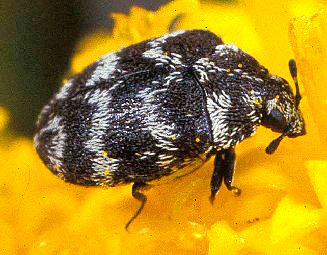|
Family: Dermestidae (hide beetles, museum beetles)
Life > Eukaryotes > Opisthokonta > Metazoa (animals) > Bilateria > Ecdysozoa > Panarthropoda > Tritocerebra > Arthopoda > Mandibulata > Atelocerata > Panhexapoda > Hexapoda
> Insecta
(insects) > Dicondyla > Pterygota > Metapterygota > Neoptera > Eumetabola >
Holometabola > Coleoptera
(beetles)
> Polyphaga > Superfamily: Dermestoidea
Dermestids are small to medium sized
beetles (2-10mm). The larvae feed on dead and dry animal matter such as
furs, skins, cured meat and decaying carcasses. They are therefore regarded as
pests of museums and stored animal products. Conversely, Dermestes maculatus
, a larger, smoother-looking beetle, is in fact used in museums to clean
flesh off bones being prepared for collections. Some species also feed on cheese
if left exposed. Adults feed on nectar and pollen.
About 30 species of dermestid beetles have been
recorded from southern Africa, including a number of introduced species.
However, there are thought to be many more species yet to be named and described.
 |
 |
|
Anthrenus verbasci, Carpet Beetle, 2mm. Feeding on pollen of a daisy. This
animal is a pest in museums as it can damage and consume valuable biological
specimens.
[image H. Robertson, Iziko ©].
|
All that remains of a once fine pinned museum insect specimen is a cluster of exuviae (shed larval skins) of the pest that ate
it, the Carpet beetle Anthrenus verbasci. The larvae are nicknamed
'woolly bears' because of their plump appearance and long hairs; they feed on
dried animal substances, especially wool and skins.
[image H. Robertson, Iziko ©]. |
Publications
Page by Margie Cochrane |
